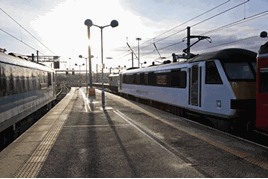The last time there was a major change to the service provision was in 1999, when Anglia Railways introduced a half-hourly frequency between Norwich and London.
Says Denby: “This is a different scale. The economic case is clear, but the next question is about how we make it actually happen in practice.”
The line has never officially had a 90-minute journey time between Norwich and London - the fastest was in the late 1990s, when the 0755 from Norwich had a booked 96-minute journey. But it only stopped at Ipswich, so if reintroduced would run counter to Pendlington’s views on a reduced service.
Says Denby: “To get to 90 minutes needs three things. Firstly, you need infrastructure upgrades and higher line speeds, plus the removal of constraints such as level crossings.
“Secondly, there need to be trains capable of 110mph. The ‘90s’ and Mk 3s are, but then there is the issue of track capacity. Faster trains cannot overtake slower ones in many places on a predominantly two-track railway.
“Rolling stock is key. That is clearly inter-city stock for the Norwich services. It is an inter-city service to Norwich now - that’s what customers and stakeholders expect, and it should be faster. The route is not just an inter-city one, but clearly the needs of an inter-city service affect the overall route capability requirements.
“To meet inter-city journey time aspirations you need higher calibre stock. This means better acceleration, quicker braking and minimising dwell times. They must fit the bill for speed, performance and customer comfort.”
Denby says that there are distinct markets along the route. Clearly there is the inter-city market, which has experienced a significant growth in demand along the route over the past 30 years. He says it is clear that stakeholders want an inter-city service on which they can both work and relax. Business travellers rely on the line.
“But equally you cannot ignore that Norwich is only 115 miles from London,” he says. “In the peak period there is a key and significant volume of passengers commuting. It is about getting the right service proposition for everyone.
“It should be remembered that the rolling stock requirements aren’t just about the inter-city trains. You could have new-generation inter-city-quality trains on the main line - and an inter-city-style EMU that gives you two extra vehicles worth of seating capacity compared with a ‘90’, Mk 3s and a DVT. But if you don’t take into account non inter-city services, you’ll end up with inter-city services catching up with non inter-city trains if they cannot accelerate fast enough.
“So another critical priority is to improve the standard and capability of the key Essex commuting services from Harwich, Clacton, Colchester, Braintree and Chelmsford into London.
“There’s an added win of markedly upgrading non inter-city services, as you improve performance as well as perceptions across all customers along the entire GEML.
“With upgraded services all the way along the route you maximise service and journey time benefits, encourage even more passengers to travel, and have an even stronger business case. The railway benefits, the region benefits, and (most importantly) so do the passengers - in Essex, Suffolk and Norfolk.
“And given that the route serves the City of London and some of the key financial services businesses that are at the heart of the national economy, the benefits would be felt wider still on the national stage.”
That the GEML upgrades are even being discussed is testament to the efforts of the Taskforce and those who worked on the 2012 prospectus. Says Denby: “There wasn’t any significant momentum on the GEML. Bow Junction was on the agenda and there was some capacity enhancement work due in CP5, but that was it.”
Timetabling is still clearly an area that needs investigating. Denby says the GEML needs optimising, and that incremental infrastructure upgrades can help. He says that service upgrades are likely to be done in three stages, with incremental infrastructure work in CP5 followed “ideally” by a step change created with new rolling stock, and then further (more significant) infrastructure upgrades in CP6.
One constraint being investigated is Trowse Swing Bridge. The single-track structure south of Norwich station was opened in 1987 and is the only electrified swing bridge in the world. However, if it fails - and it does so more often than is satisfactory - then trains cannot serve Norwich. But even more importantly, it could constrain services in the future.
“At the moment it is a notable, but just about manageable, constraint,” says Denby. “But we are at the tipping point where it becomes a much more significant barrier to progress.
“There are aspirations for Norwich to Cambridge services to run half-hourly in the long term. If you are looking to improve service frequency on Norwich to London and Norwich to Peterborough lines as well, it would not be possible with a single-track bridge.”
All of these service aspirations are being considered, with Denby telling RAIL: “We would say there is a strong case for that bridge to be a permanently fixed structure, but there are hurdles to overcome.” These involve negotiations with the Broads Authorities, and it is early days.
The Taskforce also advocates an additional service per hour between Norwich and London.
“You could effectively put a third path an hour, and that is then the fast path. By doing that nobody loses out, as infrastructure and train improvements mean faster journey times,” says Denby.
“A key element of securing stakeholder backing was that everyone on the route gains and nobody loses out. Potentially you might have the existing two trains per hour - which could be markedly faster than they are now, but with the current stopping patterns - then a third service that is even faster with only two or three stops.”
That could work well during the off-peak periods, assuming the necessary infrastructure and rolling stock upgrades have taken place.
“The peak is a challenge,” acknowledges Denby. “Other than the headline train (say the ‘East Anglian’), it will be really challenging to reach 90 minutes.”
Even so, he says that 90-minute journeys on the quickest services should be possible after the tranche of improvement works in CP6.
“We can get much closer after CP5 work, and new rolling stock towards the end of the decade would enable a significant timetable change. But getting down to around 90 minutes on a number of services will take longer.”
He says that all of the aspirations have always been discussed as a decade-long project.
“What is really encouraging is that there is real, ongoing momentum. With the election result leading to a Conservative government, there is continuity in rail policy. And given that their manifesto made explicit mention of journey time improvements in East Anglia, we can work to make sure that that commitment is fulfilled.
“We also have continuity in the Taskforce with Chloe Smith and Ben Gummer both being re-elected, who have both put real personal commitment and time into moving the agenda forward. Now it is about delivery. We need to make absolutely sure the plans are implemented and delivered.”
Denby is positive about the outcome: “I think the work done has really made the case. We have clear support, and it is about taking the momentum forward and making sure the clear benefits are delivered. We have the best chance we’ve ever had of making this happen.”
A week after RAIL met Denby, McLoughlin announced a “pause” for electrification on the MML and trans-Pennine electrification schemes. Yet in the same speech in the House of Commons, he said: “In Anglia we will bring about modern, faster trains to Ipswich and Norwich in the next franchise.”
Perhaps that momentum and effort is finally paying off…
- This feature was published in RAIL 779 on July 22 2015















Login to comment
Comments
No comments have been made yet.